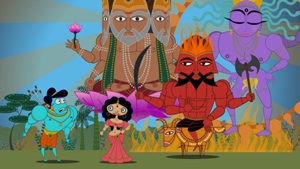Stuart:
Writer/director/animator Nina Paley has created a wonderful mix of mythology, music and eight-headed gods with Sita Sings the Blues.
The story is told on several levels. First of all, it is a retelling of the Indian epic ‘Ramayana’, which concerns the ‘good king’ Rama and his endlessly devoted wife, Sita. The tale is narrated by a trio of traditional Indian shadow puppets, who bicker casually about the specifics of events, and add their own modern-day interpretations. Interspersed with the retelling is the rather autobiographical tale of Nina and her partner, the latter of which travels to India to leave her behind. To top it all off, Sita has a habit of breaking into song. Not just any song, but the 1920s jazz tunes of Annette Hanshaw.
The tale is narrated by a trio of traditional Indian shadow puppets, who bicker casually about the specifics of events, and add their own modern-day interpretations. Interspersed with the retelling is the rather autobiographical tale of Nina and her partner, the latter of which travels to India to leave her behind. To top it all off, Sita has a habit of breaking into song. Not just any song, but the 1920s jazz tunes of Annette Hanshaw.
It’s a rather eclectic way to tell a story and for the most part, it works. Each segment is animated differently: behind the narrators is a backdrop that frequently uses a collage of photographs and still images to illustrate their point; Sita’s tale resembles the painted images you might find on ancient frescoes; the musical numbers are computer assisted, stylised versions of the same characters; and finally the biographical tale is told in a scribbly, deliberately low tech animation. It took me a moment to adjust to each of the styles, but it makes for a beautiful film overall, and strengthens the concept of concurrent narratives.
The Annette Hanshaw numbers are effective, though only to a certain extent. The first time a song popped up I quite enjoyed it, but it soon became too much. Every song is played in its entirety, and to be honest they all sound pretty much the same. They are relevant to the story, but could have done with some editing. During the second half, I almost found myself groaning each time the vinyl crackle would begin because I was desperate to continue with the central story. The ‘choreography’ also leaves a lot to be desired. At first it’s kinda cool to see Sita gyrating, but it soon becomes repetitive, and at their worst the numbers only serve to reiterate what we already know.
The narrators are the best part of the film, and their banter is so laidback that one wonders to what extent their bits were scripted. It’s a wonderful retelling, reverential but also willing to poke fun.
Sita Sings the Blues isn’t perfect. Paley’s determination to include so many songs means that the film starts to drag in the second half. It is, however, one of the most beautiful animations I’ve seen in a while, as well as being educational and emotionally-involving.
Rating: